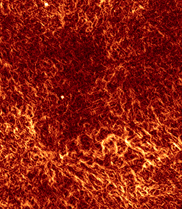The violent swirling of the gas between the stars has been captured for the first time with a CSIRO telescope.
A pit of writhing snakes – that’s what the first picture of turbulent gas in our Milky Way looks like.
Professor Bryan Gaensler of the University of Sydney, Australia, and his team used a CSIRO radio telescope in eastern Australia to make the ground-breaking image, published in the journal Nature.
“This is the first time anyone has been able to make a picture of this interstellar turbulence,” said Professor Gaensler. “People have been trying to do this for 30 years.”
Turbulence makes the Universe magnetic, helps stars form, and spreads the heat from supernova explosions through the Galaxy.
“We now plan to study turbulence throughout the Milky Way. Ultimately this will help us understand why some parts of the Galaxy are hotter than others, and why stars form at particular times in particular places,” Professor Gaensler said.
Gaensler and his team studied a region of our Galaxy about 10 000 light-years away in the constellation Norma. They used CSIRO’s Australia Telescope Compact Array because “it is one of the world’s best telescopes for this kind of work,” as Dr Robert Braun, Chief Scientist at CSIRO Astronomy and Space Science explained.
The radio telescope was tuned to receive radio waves that come from the Milky Way. As these waves travel through the swirling interstellar gas, one of their properties – polarisation – is very slightly altered, and the radio telescope can detect this.
Polarisation is the direction the waves ‘vibrate’. Light can be polarised: some sunglasses filter out light polarised in one direction while letting through other light.
The researchers measured the polarisation changes over an area of sky and used them to make a spectacular image of overlapping entangled tendrils, resembling writhing snakes.
More HERE

